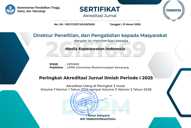Improving Verbal Communication in Stroke Patients After Lip Exercise and Blowing Pipe Intervention
(1) Universitas Islam Sultan Agung
(2) Universitas Islam Sultan Agung
(3) universitas islam sultan agung semarang
(*) Corresponding Author
Abstract
Keywords
Full Text:
PDFReferences
Suyanto S. Nursing Diagnoses Of Patients With Neurological Disorders In Ward. Media Keperawatan Indonesia 2018;1:7. https://doi.org/10.26714/mki.1.3.2018.7-11.
Pengpid S, Peltzer K. Prevalence and determinants of stroke among older adults in India: Results of a national community-dwelling survey in 2017-2018. International Journal on Disability and Human Development 2022;21:73–9.
Sackley CM, Rick C, Brady MC, Burton C, Jowett S, Patel S, et al. The effect of two speech and language approaches on speech problems in people with Parkinson’s disease: the PD COMM RCT. Health Technology Assessment (Winchester, England) 2024;28:1–141. https://doi.org/10.3310/ADWP8001.
Green-Morris G. An evaluation of the effectiveness of foot care education in rural clinics. Journal of Diabetes and Metabolic Disorders 2019;18:207–15. https://doi.org/10.1007/s40200-019-00407-0.
Suyanto S, Puspita Y, Amal AI. The Combination of Mirror Therapy and Range of Motion (ROM) Therapy Increased the Muscle Strength. Malaysian Journal of Medicine and Health Sciences 2023;19:104–8. https://doi.org/10.47836/mjmhs.19.2.16.
Jensen D, Bendsen BB, Westmark S, Riis J, Krarup AL, Westergren A, et al. Effect of Chin Tuck against Resistance Exercise in Citizens with Oropharyngeal Dysphagia—A Randomised Controlled Study. Geriatrics (Switzerland) 2022;7. https://doi.org/10.3390/geriatrics7060129.
Croiset A, Sordes F, Ritz P, Martineau C. Changes of eating behavior following an education program in a context of surgery for obesity. Medecine Des Maladies Metaboliques 2019;13:733–7. https://doi.org/10.1016/S1957-2557(19)30216-0.
Liu W, Batchelor M, Williams K. Ease of use, feasibility and inter-rater reliability of the refined Cue Utilization and Engagement in Dementia (CUED) mealtime video-coding scheme. Journal of Advanced Nursing 2020;76:3609–22. https://doi.org/10.1111/jan.14548.
Ghoreyshi Z, Nilipour R, Bayat N, Nejad SS, Mehrpour M, Azimi T. The Incidence of Aphasia, Cognitive Deficits, Apraxia, Dysarthria, and Dysphagia in Acute Post Stroke Persian Speaking Adults. Indian Journal of Otolaryngology and Head and Neck Surgery 2022;74:5685–95. https://doi.org/10.1007/s12070-021-03006-9.
Mendoza Ramos V, Paulyn C, Van den Steen L, Hernandez-Diaz Huici ME, De Bodt M, Van Nuffelen G. Effect of boost articulation therapy (BArT) on intelligibility in adults with dysarthria. International Journal of Language and Communication Disorders 2021;56:271–82. https://doi.org/10.1111/1460-6984.12595.
Wang J, Li G, Ding S, Yu L, Wang Y, Qiao L, et al. Liuzijue qigong versus traditional breathing training for patients with post-stroke dysarthria complicated by abnormal respiratory control: Results of a single-center randomized controlled trial. Clinical Rehabilitation 2021;35:999–1010. https://doi.org/10.1177/0269215521992473.
Wong MN, Baig FN, Chan YK, Ng ML, Zhu FF, Kwan JSK. Transcranial direct current stimulation over the primary motor cortex improves speech production in post-stroke dysarthric speakers: A randomized pilot study. PLoS ONE 2022;17:1–23. https://doi.org/10.1371/journal.pone.0275779.
Anderson K, Blair A. Why we need to care about the care: A longitudinal study linking the quality of residential dementia care to residents’ quality of life. Archives of Gerontology and Geriatrics 2020;91. https://doi.org/10.1016/j.archger.2020.104226.
Kim Y, Kim M, Kim J, Song TJ. Efficacy and feasibility of a digital speech therapy for post-stroke dysarthria: protocol for a randomized controlled trial. Frontiers in Neurology 2024;15:1–10. https://doi.org/10.3389/fneur.2024.1305297.
Comer AR, Damush TM, Torke AM, Williams LS. The Role of Informed Consent for Thrombolysis in Acute Ischemic Stroke. The Journal of Clinical Ethics 2019;30:338–46.
Article Metrics
Abstract view : 112 timesPDF - 2 times
DOI: https://doi.org/10.26714/mki.8.3.2025.187-192
Refbacks
- There are currently no refbacks.
Copyright (c) 2025 Suyanto Suyanto, Eko Kurniawan, Erna Melastuti

This work is licensed under a Creative Commons Attribution 4.0 International License.
This journal is indexed by:
Kedungmundu Raya No. 18 Semarang NRC Building Universitas Muhammadiyah Semarang
Phone: 02476740287
Fax: 02476740287
Email: mki@unimus.ac.id





















